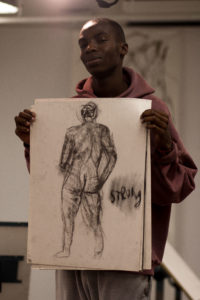By Chloe Wray
wraychlo@grinnell.edu
Holding a piece of chalk, Marco Saffold ’20 sat facing me as he sketched repetitions on the table next to him. He apologized for being fidgety. His energy, a curiosity to create, was unbridled.
His uninhibited energy transfers to his art, which prefers to remain unrestricted.
“I try not to rely too much on one medium. I find myself not able to be focus[ed] on one thing,” Saffold explained, citing the art courses he’s taking this semester as wide-ranging and multi-faceted.
An intended studio art and philosophy double major, Saffold remembers the value his parents placed on education, doing math and reading workbooks at an early age. His earliest memories of making art are from elementary school.
“It was a pretty hard time for me. I really tried taking it seriously, making stuff I would be proud of, that other people could enjoy,” Saffold said. “But other students were throwing crayons around, you know how elementary school is.”
Since elementary school, art seems to have been something that has been a constant in Saffold’s life. In middle school he prioritized taking art classes. In the mix of figuring out school and friends and oneself, Saffold admits to letting his focus on art slip in high school. He circled back to it once at Grinnell, a passion resurfaced from the backburner, something into which he knew he wanted to pour his energy and focus.
During his first year at Grinnell, Saffold joined ANACHA, an art collective started by Hanky Song ’17.
“ANACHA is a dedication to two non-western women who were murdered for being amazing artists and amazing activists,” Saffold explained. “The first portion of the name, ANA, is dedicated to Ana Mendieta. The second part is dedicated to Theresa Cha. Both great artists — theorists as well. A lot of people get confused about it, asking if there’s a dash between the names, but like we’re post-structuralists, so we don’t care about that.”
Following Song’s graduation, Saffold is now leading ANACHA along with TJ Calhoun ’20. Ironically, it has been since coming to Grinnell that Saffold has found film. Without faculty or a film department, ANACHA has begun to attempt to fill whatever voids it can. Hosting cinematography workshops, film screenings and discussions, Saffold hopes that ANACHA can provide a space for members to fulfill a component that has been neglected in Grinnell’s liberal arts education.
Aside from the opportunities the collective is creating around film, Saffold began working on his own projects last year, largely inspired by the film course he took with former professor of media studies Theresa Geller. The class’ exploration of avant-garde and post-modernism struck him, and with inspiration from Maya Deren’s “Meshes of the Afternoon,” he made his own short film.
“Maya Deren’s work is pretty strange,” Saffold said about the oddity of his own film, the plot of which loosely followed Calhoun as the protagonist who was tasked with retrieving a stolen good from a mysterious figure.
Conceptualizing the film and then realizing it, shooting it with Calhoun and Song, having to be resourceful in the face of a lack of materials and then editing all left Marco with a sense of fulfillment, the reward being a tangible project. Next, he wants to film music videos to accompany his raps.
“Whatever I do after Grinnell, I want it to be centered around me working with other people to do art. … I want [art] to be more of a collaborative thing. I know I’m a skilled artist, but at a point it gets kind of useless, like why am I doing this, it shouldn’t be something I’m doing for myself,” Saffold said.
Through ANACHA, Saffold is creating a role that tests the boundaries of what it means to be an artist for him, and what it means to ask critical questions. “Through leading this collective, I really wanted to help other people with their ideas, and I felt like that’s a whole lot more fulfilling and helps me grow as an artist as well,” Saffold said. “It’s still pretty difficult to get people to be dedicated to a project but that’s what I’m here to do, work and learn, see what works and what doesn’t.
“A lot of people who like art aren’t necessarily comfortable with art making because it’s a pretty intimidating thing for people, so they’re here to still participate and be involved with discussion.”
Saffold and Calhoun both encourage “anyone who’s not an asshole” to join the collective, which meets Wednesdays at 7 p.m. in Bucksbaum 242, and to bring with them a sense of curiosity and understanding as well as a desire to ask questions.
“We come here to make art to relieve ourselves of this place at times, and use it as a space to talk about things as well,” Saffold said of ANACHA, suggesting that perhaps his biggest project right now is a social one, one that creates a dialogue surrounding art and relies on collaboration to be sustainable.


Photos by Helena Gruensteidl








































































